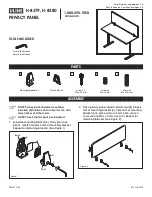
MFX types and parameters
160
r
VIMA JM-8
●
Mic Setting (1, 2, 3)—Adjusts the location of the mic that is
recording the sound of the speaker. This can be adjusted in
three steps, with the mic becoming more distant in the order of
1, 2 and 3.
●
Mic Level (0~127)—Volume of the microphone.
●
Direct Level (0~127)—Volume of the direct sound.
●
The phaser effect will be varied gradually.
●
Phaser Mode (4-Stage, 8-Stage, 12-Stage)—Number of stages in
the phaser.
●
Phaser Manual (0~127)—Adjusts the basic frequency from which
the sound will be modulated.
●
Step Rate [sync] (Hz, Note)—Use this parameter to specify
●
Step Rate [Hz] (0.05~10.00Hz)—Frequency, i.e. modulation
●
Step Rate [note] (musical notes)—Rate parameters can be set as
●
Depth (0~127)—Depth of modulation.
●
Polarity (Inverse, Synchro)—Selects whether the left and right
phase of the modulation will be the same or the opposite.
INVERSE: The left and right phase will be opposite. When using
a mono source, this spreads the sound. SYNCHRO: The left and
right phase will be the same. Select this when inputting a stereo
source
●
Resonance (0~127)—Amount of feedback.
●
Cross Feedback (–98%~0~+98%)—Adjusts the proportion of the
phaser sound that is fed back into the effect. Negative (–) set-
tings will invert the phase.
●
Step Rate [sync] (Hz, Note)—Use this parameter to specify
whether (“Note”) or not (“Hz”) the step rate should be synchro-
nized to the Arranger or Recorder tempo. Depending on your
choice, the setting range of the following parameter refers to a
speed (Hz) or a note value.
●
Step Rate [Hz] (0.10~20.00Hz)—Rate of the step-wise change in
the phaser effect.
●
Step Rate [note] (Musical Notes)—Rate parameters can be set as
●
Mix Level (0~127)—Level of the phase-shifted sound.
●
EQ Low Gain (–15dB~0~15dB)—Gain of the low frequency
●
EQ High Gain (–15dB~0~15dB)—Gain of the high frequency
●
Extremely high settings of the phase difference produce a
deep phaser effect.
●
Phaser Mode (4-stage, 8-stage, 12-stage, 16-stage, 20-stage, 24-
stage)—Number of stages in the phaser.
●
Phaser Manual (0~127)—Adjusts the basic frequency from which
●
Rate [sync] (Hz, Note)—Use this parameter to specify whether
●
Rate [Hz] (0.05~10.00Hz)—Frequency, i.e. modulation speed.
●
Rate [note] (musical notes)—Rate parameters can be set as a
●
Depth (0~127)—Depth of modulation.
●
Resonance (0~127)—Amount of feedback.
●
Mix Level (0~127)—Level of the phase-shifted sound.
●
Panpot (L64~0~63R)—Stereo location of the output sound. This
●
EQ Low Gain (–15dB~0~15dB)—Gain of the low frequency
●
EQ High Gain (–15dB~0~15dB)—Gain of the high frequency
●
A phaser that continues raising/lowering the frequency at
which the sound is modulated.
●
Mode (1, 2, 3, 4)—Higher values will produce a deeper phaser
effect.
●
Speed (–100~100)—Speed at which to raise or lower the fre-
quency at which the sound is modulated (+: upward/–: down-
ward).
●
Resonance (0~127)—Amount of feedback.
●
Mix Level (0~127)—Level of the phase-shifted sound.
●
Panpot (L64~0~63R)—Stereo location of the output sound. This
●
EQ Low Gain (–15dB~0~15dB)—Gain of the low frequency
●
EQ High Gain (–15dB~0~15dB)—Gain of the high frequency
●
Ring Modulator is an effect which applies amplitude modula-
tion (AM) to the input signal, producing bell-like sounds. You
can also change the modulation frequency according to the
volume of the sound input to the effects device.
●
Frequency (0~127)—Sets the frequency at which modulation
will be applied.
●
Sens (0~127)—Sets the amount of frequency modulation
applied.
●
Polarity—Determines whether the frequency modulation moves
towards higher frequencies (UP) or lower frequencies (DOWN).
●
EQ Low Gain—Adjust the low frequency gain (amount of boost
or cut). Positive (+) settings will emphasize (boost) the low fre-
quency range.
●
EQ High Gain—Adjust the high frequency gain (amount of
boost or cut). Positive (+) settings emphasize (boost) the high
frequency range.
●
Balance—Sets the volume balance between the direct and the
effect sound. With a setting of D100:0W only the direct sound
will be output and with a setting of D0:100W the effect sound
will be output.
●
This is a ring modulator that uses a 16-step sequence to vary
the frequency at which modulation is applied.
●
Step 1~16 (0~127)—Frequency of ring modulation at each step.
●
Rate [sync] (Hz, Note)—Use this parameter to specify whether
●
Rate [Hz] (0.05~10.00Hz)—Rate at which the 16-step sequence
will cycle.
●
Rate [note] (musical notes)—Rate parameters can be set as a
●
Attack (0~127)—Speed at which the modulation frequency
changes between steps.
●
EQ Low Gain (–15dB~0~15dB)—Gain of the low frequency
●
EQ High Gain (–15dB~0~15dB)—Gain of the high frequency
●
Balance (D100:0W, D50:50W, D0:100W)—Volume balance
between the direct (D) and the effect sound (W).
2-STACK
large sealed enclosure
12 x 4
condenser mic
3-STACK
large sealed enclosure
12 x 4
condenser mic
JM-8_OM_GB.book Page 160 Wednesday, July 29, 2009 4:43 PM
Summary of Contents for VIMA JM-8
Page 1: ...r Owner s Manual JM 8_OM_GB book Page 1 Wednesday July 29 2009 4 43 PM ...
Page 174: ...174 rVIMA JM 8 JM 8_OM_GB book Page 174 Wednesday July 29 2009 4 43 PM ...
Page 175: ...For EU Countries For China For China JM 8_OM_GB book Page 175 Wednesday July 29 2009 4 43 PM ...
Page 176: ...R 602 00 0323 01 RES 736 09 JM 8 OM E JM 8 Cov 3 4 GB Page 176 Thursday July 30 2009 10 30 AM ...
















































